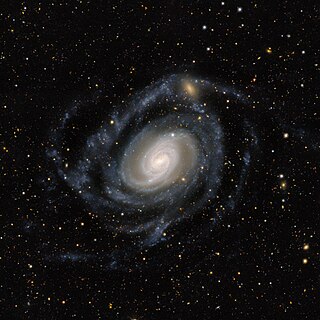Loading AI tools
Galaxy in the constellation of Sculptor From Wikipedia, the free encyclopedia
NGC 289 is a spiral galaxy in the southern constellation of Sculptor, located at a distance of 76 megalight-years from the Milky Way.[3] It was discovered on September 27, 1834, by John Herschel. The compiler of the New General Catalogue, John Louis Emil Dreyer, noted that NGC 289 was "pretty bright, large, extended, between 2 considerably bright stars".[4] The plane of the galaxy is inclined by an angle of 45° to the line of sight from the Earth.[5]
| NGC 289 | |
|---|---|
 Hubble Space Telescope image of NGC 289 | |
| Observation data (J2000 epoch) | |
| Constellation | Sculptor |
| Right ascension | 00h 52m 42.365s[1] |
| Declination | −31° 12′ 20.99″[1] |
| Redshift | 0.0054[2] |
| Heliocentric radial velocity | 1,628 km/s[3] |
| Distance | 76.1 Mly (23.33 Mpc)[3] |
| Apparent magnitude (V) | 11.0[4] |
| Apparent magnitude (B) | 11.4[2] |
| Characteristics | |
| Type | SB(rs)bc[5] |
| Apparent size (V) | 3.1' x 2.5'[4] |
| Other designations | |
| MCG -05-03-010, IRAS 00502-3128,[2] PGC 3089, 2MASSX J00524236-3112209 | |
This is a Type II Seyfert galaxy with an active galactic nucleus. A dust lane is seen crossing the nucleus, and there are indications of recent starburst activity nearby.[6] NGC 289 is a giant, gas-rich, low surface brightness galaxy with a small bulge at the nucleus, a small central bar, and two inner spiral arms. These arms split into multiple parts as they extend into the outer disk. The galaxy has a dark matter halo that has an estimated 3.5 times the mass of the gaseous and stellar components. There is a dwarf elliptical companion to the north of the galaxy,[7] designated Arp 1981,[6] that may be having a perturbing influence.[7]
Seamless Wikipedia browsing. On steroids.
Every time you click a link to Wikipedia, Wiktionary or Wikiquote in your browser's search results, it will show the modern Wikiwand interface.
Wikiwand extension is a five stars, simple, with minimum permission required to keep your browsing private, safe and transparent.